Acer V7-482PG-9884 Review: Everything You Need
by Jarred Walton on August 24, 2013 12:00 AM ESTAcer V7 Gaming Performance
Our focus for gaming performance is going to be on our Value and Mainstream settings, although we’ve also run our Enthusiast settings and as usual you can find the results in Mobile Bench. The short summary is that in most cases, the Aspire V7 easily handles the Value settings and typically gets above 30 FPS on the Mainstream settings; what that means for 1080p gaming is that medium detail should suffice, but anything more and you’re often going to drop below 30 FPS. I’ll save additional commentary for after the graphs break….
One other item to discuss before we get to the gaming benchmarks is the 4GB DDR3-1800 RAM used on the GT 750M. I commented earlier that the amount of RAM is overkill, and the decision to use DDR3 instead of GDDR5 would likely reduce performance quite a bit. There are of course ways to mitigate this, as well as investigate how much the GPU memory bandwidth limits performance. I installed MSI Afterburner 3.0 Beta 14 (gotta love the monthly betas that keep expiring...), and proceded to overclock just the RAM. Initially I tried for DDR3-2500, but that resulted in a frowny-faced BSOD (Windows' 8 has a much nicer BSOD, apparently). DDR3-2300 failed as well, but without the BSOD, while DDR3-2200 ran through all of our gaming benchmarks without issue. That represents a 22% overclock of the RAM, and I've included the results in the charts below.
Value Gaming Performance
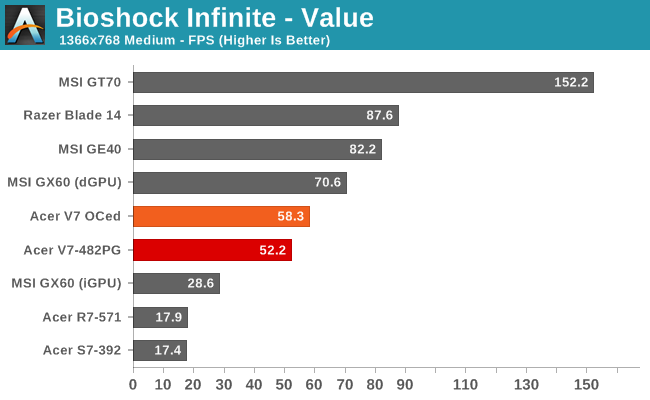
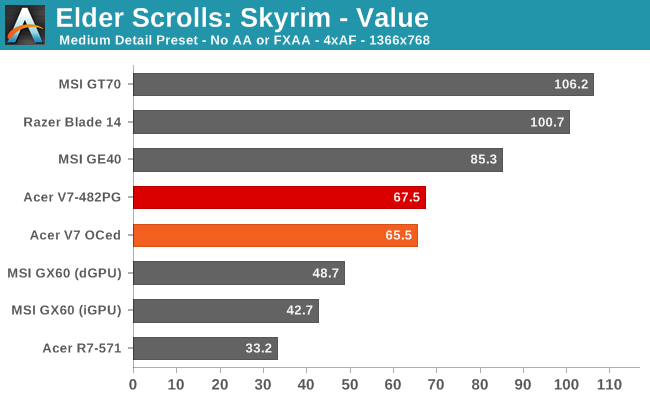
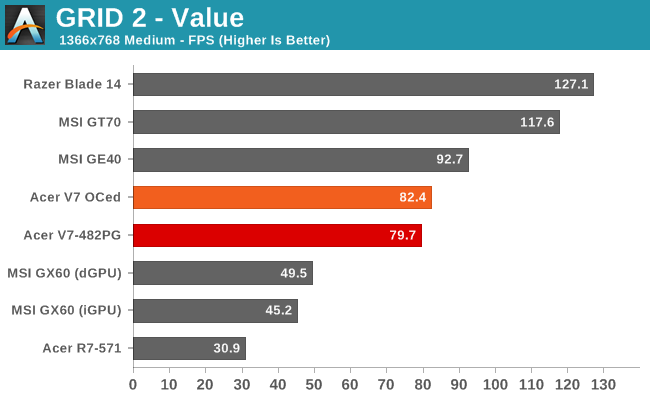

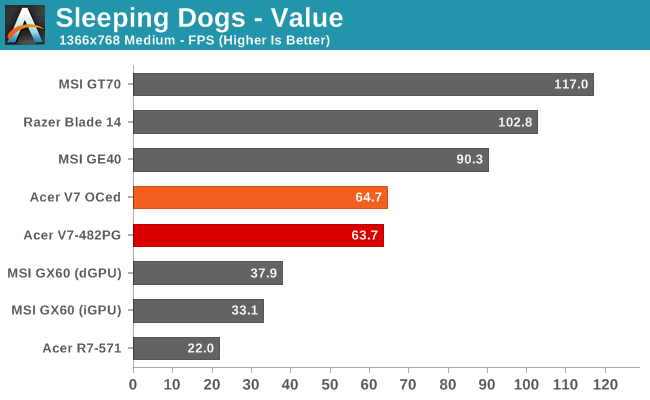
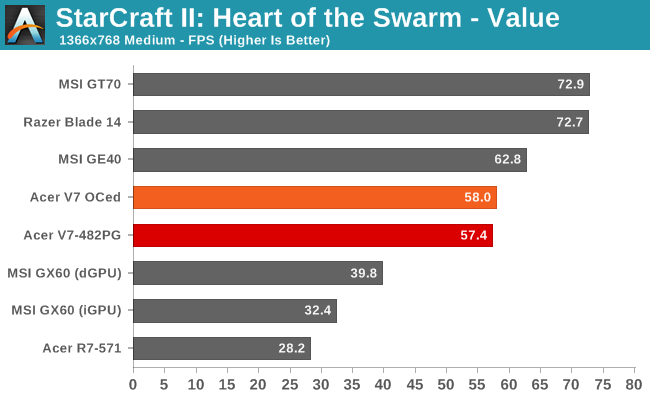
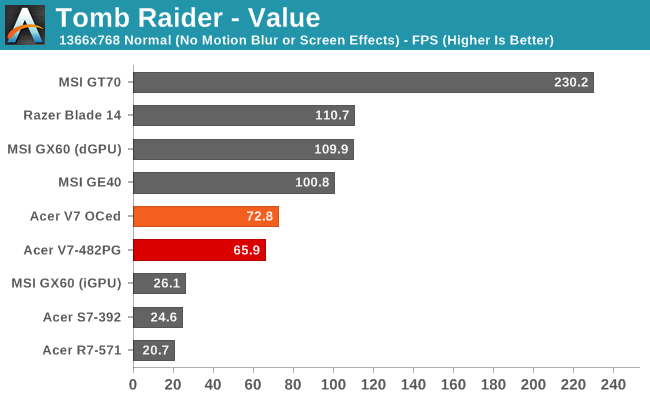
Mainstream Gaming Performance
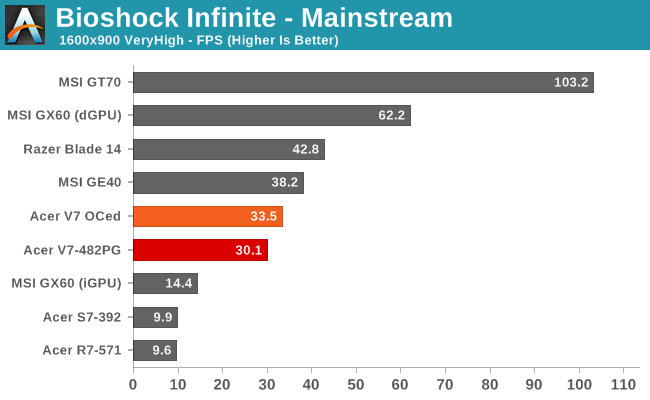

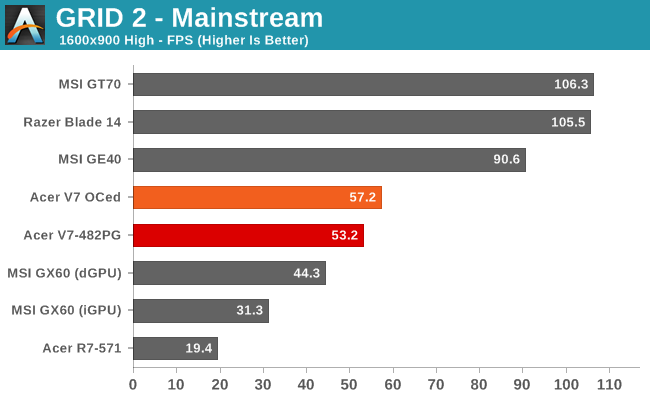
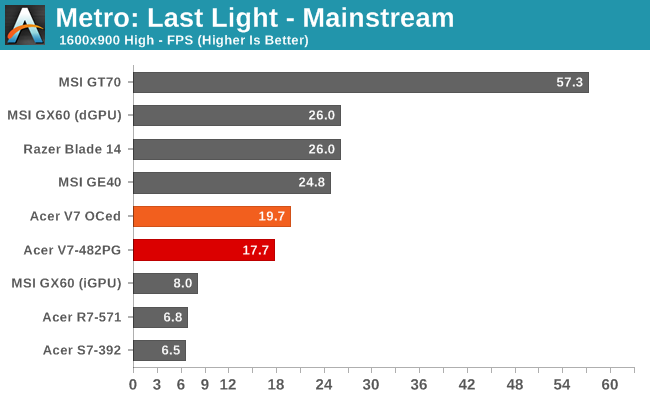
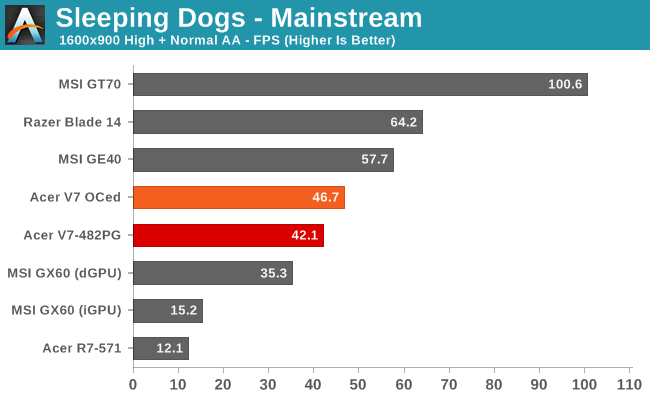


The two most demanding games in our test suite right now are Metro: Last Light and Company of Heroes 2 – I didn’t include graphs for the latter above, simply because we’ve only run it on three laptops so far, but it ends up being the slowest running game in our suite by far to the tune of 23.7 FPS at 1366x768 medium/low settings. It’s basically the opposite of StarCraft 2: Heart of the Swarm, where it apparently pounds the GPU (shaders) and doesn’t require as much of the CPU. Speaking of which, Skyrim and StarCraft 2 are in the interesting camp of being more CPU limited, so we actually see better numbers from the Aspire V7 with GT 750M than we get from the MSI GX60 with HD 7970M, even at our Mainstream settings. Somewhat surprisingly, GRID 2 and Sleeping Dogs also fall into that category, at least if we limit ourselves to the Mainstream settings.
It all goes back to what I was talking about in the introduction: balance. The Acer V7 is certainly not the fastest laptop on the block, and the GT 750M really has no business outperforming an HD 7970M. The problem is the CPU-GPU balance in the GX60 is just way off. In some games like Tomb Raider and Bioshock Infinity, even moderately slow CPUs are fast enough; in other cases, however, more (single-threaded) CPU performance is required. In an Ultrabook like the V7, I think the GT 750M is a pretty good fit for a Haswell ULT CPU.
My only wish is that Acer had equipped the GPU with 2GB GDDR5 memory; I don’t know exactly how much that would have helped, but simply overclocking the DDR3 memory by 22% produced some interesting results. At our less demanding Value settings, the overclock only improves performance by 3.6% on average, and in one game at least (Skyrim) it was actually slightly slower. The reason for the lack of improvement is that Value settings tend to be more CPU constrained, so increasing the GPU performance doesn't always help much; still, Bioshock and Tomb Raider both improve by over 10%. Move up to the Mainstream settings and the increased memory bandwidth becomes far more useful. There we see an average performance increase of 11.5%, and only Skyrim and GRID 2 fail to post double digit percentage improvements.
If all of this can be achieved with a 22% overclock of DDR3 RAM, what would more than doubling the bandwidth with GDDR5 accomplish? It definitely wouldn't reduce performance, and I wouldn’t be surprised to see an extra 15-30% performance increase at our Mainstream settings for a relatively minor change in BOM costs. Even without GDDR5, though, the Acer V7 posts respectible numbers and can handle most games at 1080p and Medium detail. It's not a gaming enthusiasts dream laptop, but for less demanding gamers it's more than sufficient.










62 Comments
View All Comments
damianrobertjones - Tuesday, August 27, 2013 - link
"I’m frequently amazed at how much better battery life is with Apple hardware under OS X" - I didn't see this in the last gen of macbooksI hope that this machine, as well as the Sony, is mentioned in future battery sections as the Mac DOES NOT PROVIDE the best battery life.
http://www.pcpro.co.uk/reviews/laptops/383785/dell...
JarredWalton - Tuesday, August 27, 2013 - link
Their "Light" battery test is not the same test that we use, nor is it at the same brightness setting. The MacBook Air 13 Haswell model gets 11.03 hours while loading four web pages every 60 seconds with the LCD at ~200 nits. They measured 12.68 hours of battery life doing what? "The light-use test is the absolute longest you can expect the battery to last with careful power management." That sounds like they're doing nothing, equivalent to our old "Idle" battery life testing from last year, and possibly at minimum brightness.We haven't been doing Idle testing for 2013, but on laptops tested previously idle battery life was typically 20% to as much as 40% more than what we got on our Internet testing. Our new Light test is our old Internet test with the LCD at 200 nits, so basically take the MBA13 result and multiply by at least 1.2 to be fair, and possibly as much as 1.4. That means the MBA13 under OS X while idle could easily hit 15+ hours, which would be more than any Windows laptop manages with a similar size battery.
Basically, you have to make sure you're comparing apples to apples when it comes to battery life testing. If a site doesn't completely document how they're testing, you can't do that.
willstay - Wednesday, August 28, 2013 - link
"Anand didn’t test Windows battery life with the new MBA13" - I wish he did. No one has done it with MBA13 yet.ihleonard - Saturday, August 31, 2013 - link
Since these don't seem to be available/on display in store anywhere, I want to get some idea of what they feel like before I take the plunge and get one. Are there any Acers (or other laptops) with a similar keyboard feel that are widely available in store; I just want to make sure that the low travel is ok.Thanks
Otunia - Monday, September 2, 2013 - link
This PC shows why 16:9 screens are bad. I'm writing this comment on an old 16:10 laptop which is as wide as this new Acer and guess? My screen is 15" thanks to all those extra vertical pixels.There are two extra downsides of this PC: the memory limit at 12 GB (why not two 8+8 GB unsoldered slots? For the extra thinness? Who cares!) and the glossy screen. So even if the keyboard and the touchpad turn to be super we are left with a subpar screen and constrained memory. The rotational disk would be OK if it can be upgraded later on.
A good attempt but please try again. Hint: just clone the 16:10 matte MBP 15" and perfect it by letting people upgrade its parts.
Hrel - Tuesday, September 3, 2013 - link
While I'm sure Microsoft is pushing for manufacturers to include touchscreens; it adds NO value right now. So the problem then becomes, if you include a touchscreen you can't charge for it. Which means reduced margins. I'm certainly not going to pay for it. This thing is at least $100 too expensive.Looks like a good machine though, if I could find it on sale for 1K I'd probably buy it.
ziotoo - Sunday, September 8, 2013 - link
Hey jared (or any v7 owner)My laptop died and thought of upgrading to the acer v7
The question is: i do design on my laptop, both 2d (photoshop, vectorial, animation, video editing) as well as 3d (from cad to maya/max). This is the first mainstream laptop i see with a decent dedicated graphic solution, and since i also do photo retouching you pretty much sold me on the screen. I travel a lot and the v7 is light and has the perfect screen format for me. It's also 1000eur in europe, wich is a really good price for this kind of product.
The problem is the i5 cpu. I've had a first gen i7 (i think 720 qm) quad core cpu for the past years and it was enough for me. But i'm scared that the acer v7 will actually offer worse performance with its 4th gen dual core i5 than my old laptop. Am i right to be worried? And would an i7 4500u actually be much better, even though that's also a dual core? It's gettong very hard to find quad core cpus in the 2kg weight range.
Thanks a lot.
ziotoo - Sunday, September 8, 2013 - link
Forgot to add: the 14 inch configuration in europe only sports an i5. The rest is unchangedhellermercer - Friday, November 22, 2013 - link
I need powerfull speakers!!!!hellermercer - Friday, November 22, 2013 - link
I need powerfull speakers!!!!